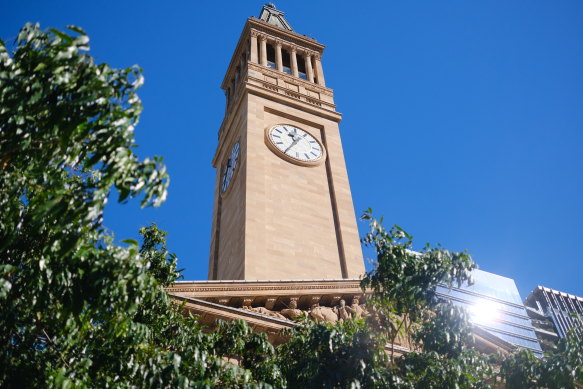- Perspective
- Politics
- Queensland
- Council election
This was published 11 months ago
Brisbane has more cash to splash than most councils. But whose is it?
By Matt Dennien
Since the calendar flicked over to 2024, both the Labor and Greens campaigns for City Hall have pitched lowering (or scrapping) various public transport fares.
But with the overlapping spheres of government influence, both also come with an asterisk: the state, which controls or also has a role in the systems, would need to allow it.

Key plans pitched at voters ahead of next weekend’s City Hall election rely on big changes (or dollars) from other governments. It’s not the first time.Credit: Matt Dennien
This reliance on the generosity or willingness of higher levels of government to help is still a dilemma for a council as big as Brisbane – with more residents than some states, and ambitions to match.
For it’s part, the state government says it would welcome any initiative which encouraged public transport use. Just as long as the council footed the bill.
“However, any reduction or removal of fares would need to be absorbed by the council,” Transport Minister Bart Mellish told Brisbane Times in a statement.
The state is more opaque when asked about one measure the Greens have pitched to help fund an ambitious policy platform.
While a proposed scaling back of spending on road-widening programs in favour of more public and active transport links could be done by council itself, a cap on how much the council can charge developers for infrastructure is set by the state.
The Greens want this lifted. Local Government Minister Meaghan Scanlon said only that her government would continue to work with councils and the industry on the infrastructure charges.
Focus from the Greens on this potential revenue stream comes after the LNP council administration under Lord Mayor Adrian Schrinner announced a raft of discounts for developers last year.
Budget documents show the council’s expected take drop to about $178 million this financial year – down from about $253 million the one prior).
Brisbane Labor now opposes this too (accusing the LNP of favouring private developers) but supports the lower costs for community housing providers.
While the solely rates, roads and rubbish domain of councils has been waning for some time, this is particularly so in Brisbane.
On the rubbish front, the council Labor campaign is also hoping for cash from their state counterparts to fund another of their major policy pitches.
Green-top bins for residents, and weekly collection, would allow disposal of food waste into a council-wide compost scheme eventually able to help fund itself by on-selling the end product.
Brisbane Times asked the Labor campaign a direct question about the estimated cost of the plan last week, which was not answered in a response from lord mayoral candidate Tracey Price.
The party has only said it expects to receive funding from the state government through programs supporting the FOGO push.
And it’s not only Labor and the Greens who are leaning on other levels of government to help make their plans happen – or not.
Many will remember Lord Mayor Adrian Schrinner’s pitch ahead of the last council election for five new green bridges in five-to-10 years at a cost of $550 million – a third of which would need to come from the state or federal governments.
The then-Coalition coloured Commonwealth coughed up some cash – as it did for the Metro bus project. The Labor state government did not, and made a show of it.
Fast-forward to 2024, and one bridge has been built, the flagship is set to open this year (both likely to chew up $350 million), one has been all-but dumped and the future of two remain unclear.
Cost increases on this and other projects, while being felt globally, have been pointed to by Labor and the Greens as part of the reason behind the $400 million needed to be trimmed from council spending just months after last year’s budget.
That hasn’t been the only recent show of belt-tightening by the Schrinner administration. But things were not always so.
Brisbane’s ability to borrow more or service growing debts and other financial liabilities now worth $5.8 billion, greater than its $3.1 billion in annual revenue, got the worst mark statewide in the latest Auditor-General report into the sector.
Asked if debt levels needed to be reduced, Lord Mayor Adrian Schrinner said in a statement that it was important to balance investment in infrastructure for the future with costs to residents, noting the council’s credit rating remained strong.
Despite regular modest surpluses, Labor has long criticised the LNP’s debt management. While Greens lord mayoral candidate Jonathan Sriranganathan says it would be good to eventually pay down what’s owed, his priority was that the city has the infrastructure for development and population growth.
Without hiking residents’ rates and other fees too much, or significantly reducing debt or costs, other council revenue streams such as state public transport payments or contributions from developers will need to increase to help keep the audit office happy.
Otherwise, those running the council bank accounts after March 16 might need to start rattling the can a little harder for state and federal funding. Whether either are in the mood to hand it over is another question.
Get the inside word on the news, sport, food, people and places Brisbane is talking about. Sign up for our City Talk newsletter here.